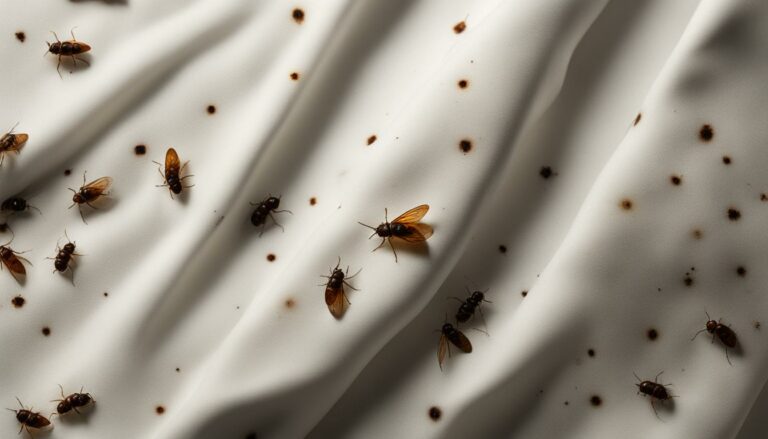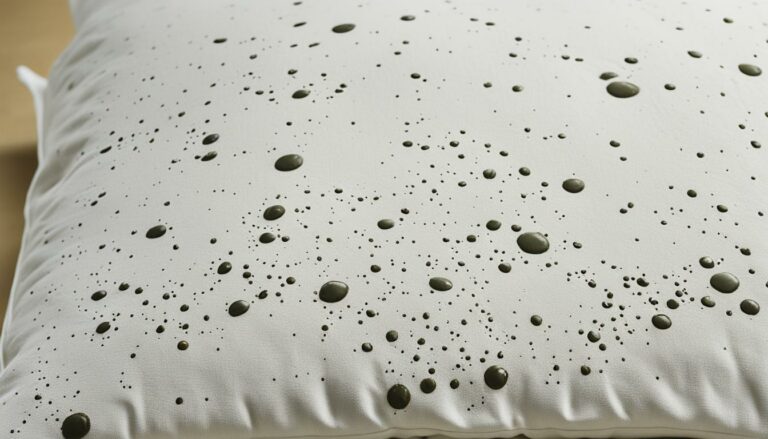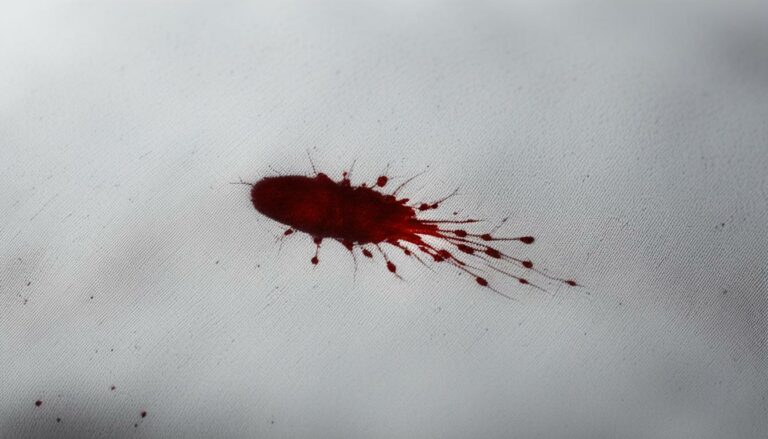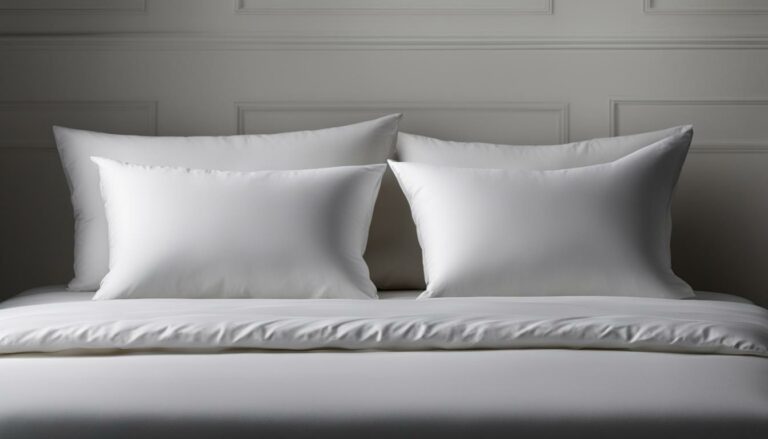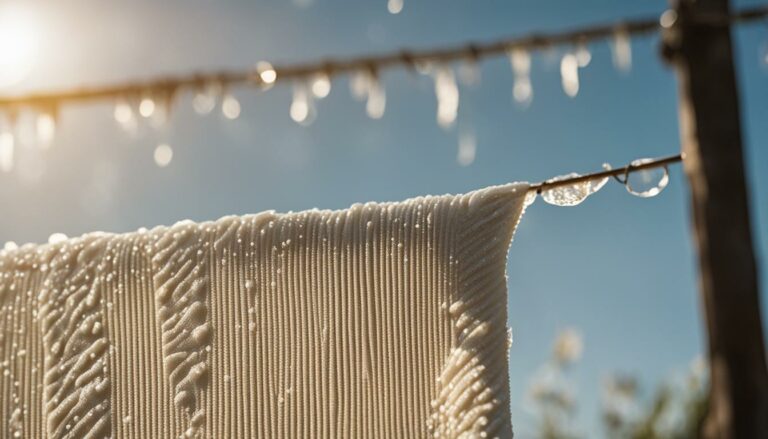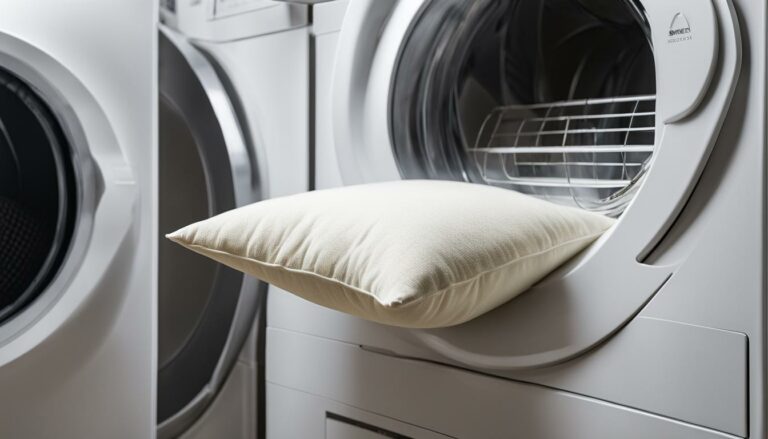Drying Feather Pillows in a Dryer: Safe Tips
Eric Christie stands as a luminary in the bedding industry, with a career spanning nearly four decades since the early 1980s. His journey through the world of bedding has seen him wear many hats – a manufacturer, designer, and retailer, showcasing his versatility and expertise in Read more...
pillowsandbedsheets.com and its partners may earn a commission if you purchase a product through one of our links
Are you wondering if you can dry feather pillows in the dryer? The answer is yes! Drying feather pillows in a dryer is not only safe but also a convenient way to maintain their plush feel and freshness. Regularly washing your feather pillows can help eliminate dust mites, bacteria, dirt, stains, and oils, ensuring a cleaner and healthier sleep environment.
Before we dive into the details of drying feather pillows, it is important to understand the difference between down pillows and feather pillows. This knowledge will help you care for them properly and prolong their lifespan.
What is the Difference Between Down Pillows & Feather Pillows?
Down pillows are made from the soft fibers that come from the undercoating of goose feathers. They have excellent insulating qualities and provide a luxurious, fluffy fill that cradles your head and neck.
Feather pillows, on the other hand, are filled with wing and back feathers. They are flatter and heavier compared to down pillows, offering a firmer support. However, feather pillows tend to lose their shape faster and may require regular fluffing to maintain their desired loft.
Now that you know the difference, let’s explore how to clean and dry your feather pillows to keep them fresh and cozy.
Key Takeaways:
- Drying feather pillows in a dryer is safe and convenient.
- Understanding the difference between down pillows and feather pillows is essential for proper care.
What is the Difference Between Down Pillows & Feather Pillows?
When it comes to choosing the perfect pillow, understanding the difference between down pillows and feather pillows is essential. Both options offer unique qualities that can enhance your sleeping experience. Let’s take a closer look at each type:
Down Pillows
Down pillows are crafted from the soft fibers found in the undercoating of goose feathers. This premium fill is known for its exceptional insulation and luxurious fluffiness. The down clusters create a light and airy feeling, providing optimal comfort and support. These pillows are ideal for those who prefer a plush and lofty sleeping surface.
Feather Pillows
On the other hand, feather pillows are filled with a combination of wing and back feathers. These feathers are slightly heavier and flatter compared to down clusters, offering a firmer sleeping surface. While feather pillows may not provide the same level of softness as down pillows, they still offer excellent support and durability. However, feather pillows may require more frequent fluffing to maintain their shape over time.
Now that you know the difference between down pillows and feather pillows, you can choose the option that best suits your sleeping preferences and comfort needs.
| Down Pillows | Feather Pillows |
|---|---|
| Soft and fluffy fill | Firmer and flatter fill |
| Lightweight | Slightly heavier |
| Excellent insulation | Good support |
| Retains loftiness | May require more fluffing |
How to Clean Down Pillows
Down pillows are a cozy and luxurious addition to any bed. To keep them clean and fresh, regular cleaning is essential. Follow these steps to effectively clean your down pillows:
Preparation
- Start by removing any pillowcases or coverings from the pillows.
- Inspect the pillows for any rips or tears. If you find any, mend them before washing to prevent further damage.
Washing Process
Cleaning down pillows is a straightforward process if done correctly:
- For better balance, it is recommended to wash two pillows at a time.
- Choose a low-sudsing laundry detergent formulated for delicate fabrics.
- Set your washing machine to the delicate cycle with warm or cool water. Hot water can kill dust mites but may damage the feather filling.
- Start the wash cycle, allowing the pillows to agitate for a few minutes and then pause the cycle.
- Press down on the pillows gently to help distribute the detergent and clean them thoroughly.
- Resume the cycle, allowing it to run through the rinse and spin cycles. The extra rinse and spin cycles help remove any excess moisture and soap residue.
Final Steps
Once the washing process is complete, it’s important to dry the pillows properly to prevent mildew or musty odors:
- Remove the pillows from the washing machine and gently squeeze out any excess water.
- Place the pillows in the dryer on a low-heat or no-heat setting.
- Check the pillows frequently while they are drying, fluffing them between cycles to help restore their loftiness.
- Once the pillows are completely dry, fluff them one final time to remove any clumps and ensure they are ready for use.
Following these steps will help you maintain clean and fresh down pillows that provide the utmost comfort for a restful night’s sleep.
Can You Dry a Feather or Down Pillow in the Dryer?
Yes, you can safely dry feather and down pillows in a dryer. Here are some simple steps to follow:
- First, remove excess water from the pillows by gently pressing them between towels.
- Next, place the pillows in the dryer.
- Set the dryer to a delicate cycle with a low-heat or no-heat setting.
- Check the pillows periodically during the drying process.
- Fluff the pillows between cycles to ensure even drying.
- If available, add dryer balls to help maintain the pillows’ fluffiness.
- Once the pillows are dry, gently fluff them and remove any clumps that may have formed.
Drying feather pillows in the dryer helps remove any remaining moisture and ensures they are thoroughly dry before use. Remember to avoid high-heat settings, as this can damage the feathers or down filling.
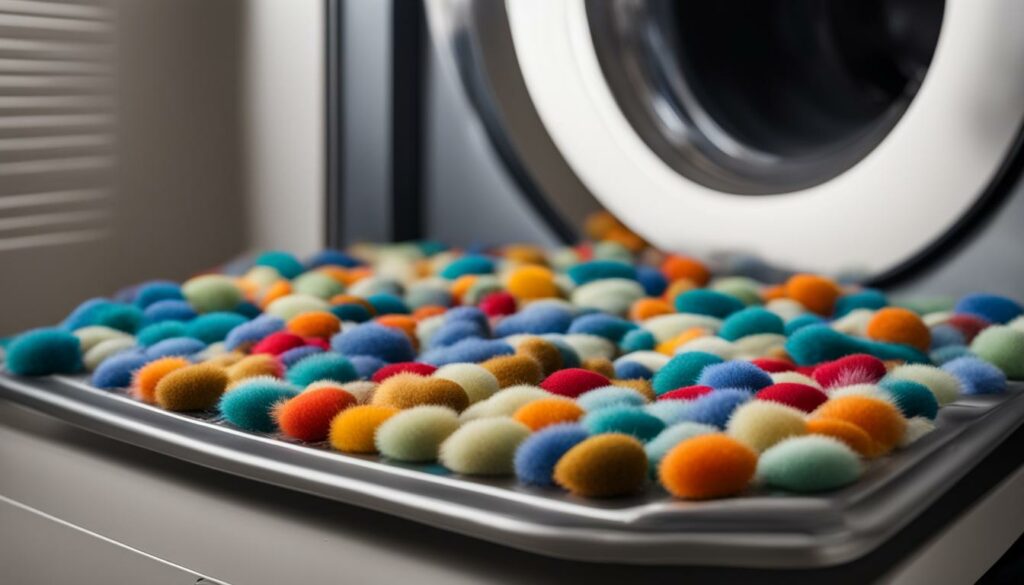
By following these tips, you can safely and effectively dry your feather and down pillows, keeping them clean and comfortable for a good night’s sleep.
How to Freshen A Down Pillow
Between washings, you can freshen your down pillows to keep them feeling and smelling fresh. Here’s a simple method to achieve that:
- Start by placing your down pillows in the dryer.
- Add a damp washcloth, a few dryer balls, and a fabric softener sheet.
- Set the dryer to a low heat setting.
- Tumble dry the pillows for 15-20 minutes.
During this time, the damp washcloth and fabric softener sheet will help eliminate any odors, while the dryer balls will fluff the pillows, restoring their plushness. The low heat setting ensures that the pillows are gently warmed without causing any damage to the down filling.
Why This Method Works
The combination of the damp washcloth, dryer balls, and fabric softener sheet helps to freshen up your down pillows in multiple ways:
- The damp washcloth introduces moisture to the pillows, which helps revive the natural softness and loft of the down filling.
- The dryer balls create gentle agitation, allowing air to circulate and fluff up the pillows.
- The fabric softener sheet adds a pleasant scent, leaving your pillows smelling fresh and clean.
This simple technique can be done in between regular washings to keep your down pillows feeling like new. It’s a quick and easy way to maintain their comfort and extend their lifespan.
Remember to follow the care instructions provided by the manufacturer for your specific down pillows, as different brands and types may have slight variations in recommended cleaning methods.
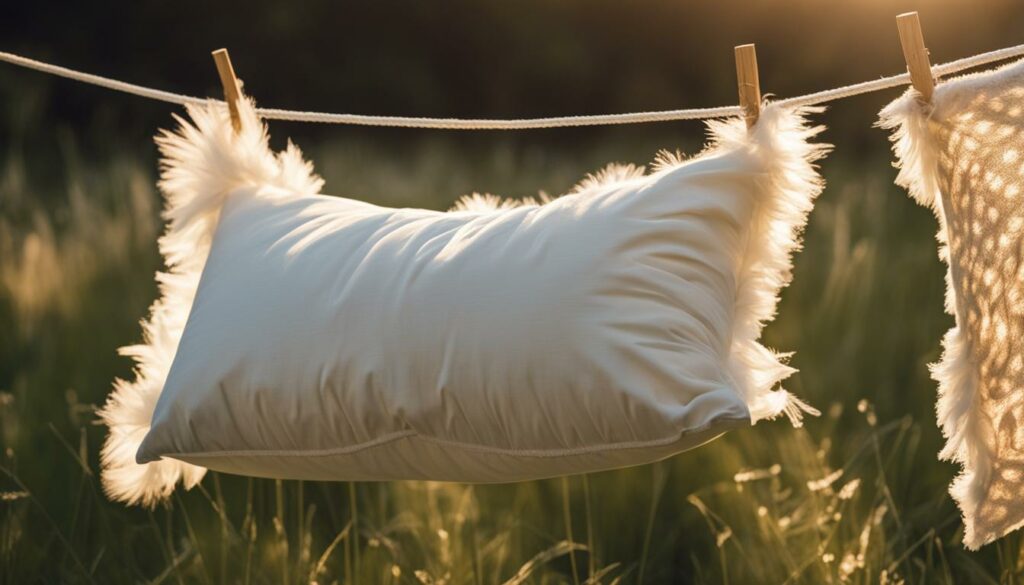
With this method, you can enjoy the comfort and freshness of your down pillows for a longer period of time. Next, we’ll explore some tips on how to make your pillows last even longer.
How to Make Your Pillows Last Longer
To ensure that your pillows provide comfort and support for a long time, there are a few simple steps you can take. By implementing these strategies, you can make your pillows last longer and avoid the need for frequent replacements.
Use Pillow Protectors
One effective way to extend the lifespan of your pillows is by using pillow protectors. These protective covers act as a barrier, preventing dirt, oils, and other contaminants from seeping into the pillow filling. Pillow protectors can be easily washed in the machine, eliminating the need to clean the pillows themselves frequently.
Not only do pillow protectors keep your pillows cleaner for longer, but they also help maintain their shape and support. By reducing exposure to sweat and body oils, pillow protectors can prevent the accumulation of odor and extend the freshness of your pillows.
Regularly Fluff Your Pillows
Another way to make your pillows last longer is by regularly fluffing them. Fluffing helps redistribute the filling and restore the pillow’s shape and loft. By doing this simple task every few days, you can prevent the pillows from becoming flattened or lumpy over time.
To fluff your pillows effectively, give them a gentle shake and knead them with your hands. This motion helps loosen the filling and allows air to circulate, keeping your pillows fluffy and comfortable. Additionally, fluffing can help eliminate any clumps that may have formed during use or washing.
Use Low Heat Settings
When it comes to drying your pillows or using a dryer to freshen them up, opt for low heat settings. High heat can damage or shrink the filling of your pillows, reducing their lifespan. By using a gentle, low-heat drying cycle, you can ensure that your pillows retain their shape, loft, and overall quality.
It is also advisable to avoid using high heat settings when washing pillow protectors. High temperatures can cause shrinkage or fabric damage, rendering the protectors less effective. Follow the care instructions provided by the manufacturer to maintain the integrity of both your pillows and pillow protectors.
By following these simple tips, you can make your pillows last longer and enjoy their comfort and support for years to come.
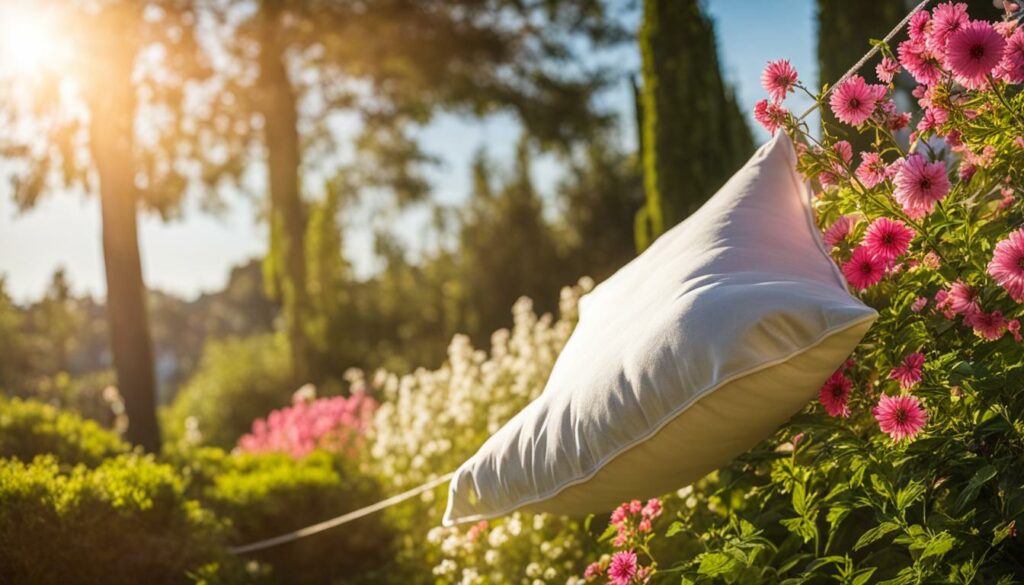
How Often Should You Wash Your Pillows?
When it comes to pillow washing, finding the right balance between cleanliness and preservation is key. Over time, pillows accumulate dirt, sweat, oils, and even allergens. Washing your pillows regularly can help keep them clean and fresh, ensuring a comfortable sleep experience. But how often should you wash your pillows?
Experts recommend washing pillows every six months to maintain their cleanliness and remove any buildup. This frequency may vary based on individual preference and pillow usage. For example, if you suffer from allergies or have sensitive skin, you may want to wash your pillows more frequently to eliminate potential irritants. On the other hand, if you use pillow protectors, you can extend the time between washings.
Pillow protectors act as a barrier between your pillow and pillowcase, preventing sweat, oils, and other substances from seeping into the pillow filling. They are easily removed and machine washable, making them a convenient option for maintaining pillow hygiene. By using pillow protectors, you can reduce the frequency of pillow washing, keeping your pillows cleaner for longer.
While washing your pillows regularly is important, it’s equally crucial to follow the manufacturer’s instructions or care label. Different types of pillows may require specific washing instructions to preserve their quality and longevity. Always check the label or consult the manufacturer’s website for guidance on washing your particular pillow.
Frequency of Pillow Washing
| Type of Pillow | Recommended Wash Frequency |
|---|---|
| Down Pillows | Every 6 months |
| Feather Pillows | Every 6 months |
| Synthetic Pillows | Every 6-12 months |
| Memory Foam Pillows | Varies by manufacturer; consult care label |
By following the recommended washing frequency and using pillow protectors, you can ensure that your pillows remain clean, fresh, and free from allergens, providing you with a comfortable and healthy sleep environment. Remember, a little extra care goes a long way in extending the lifespan of your pillows and maintaining their quality.
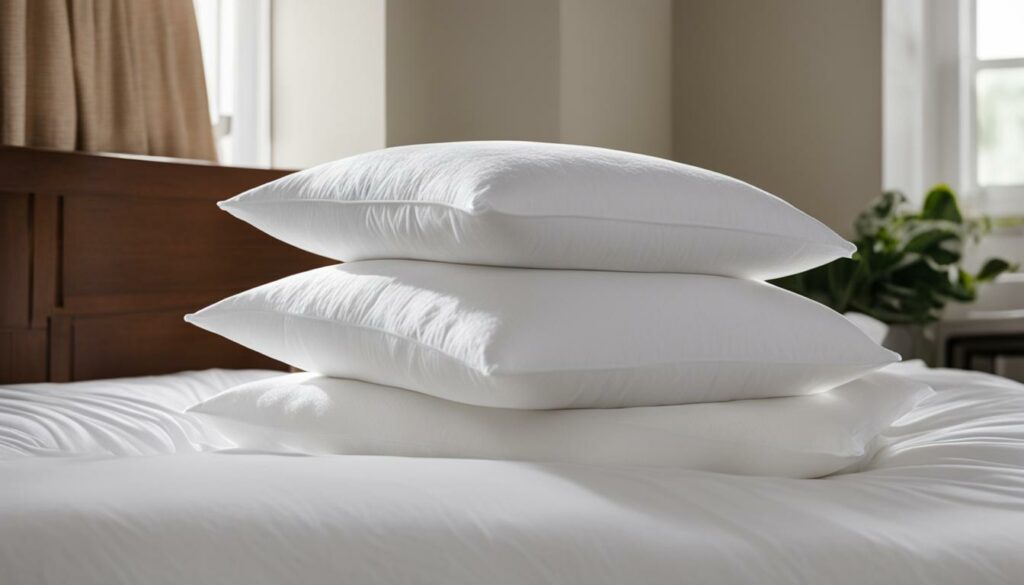
Now that you know how often to wash your pillows, let’s explore the pros and cons of using pillow protectors in the next section.
Pros and Cons of Pillow Protectors
Using pillow protectors has several benefits that can prolong the life of your pillows and enhance your sleeping experience. One of the primary benefits is that pillow protectors help keep your pillows cleaner for longer periods. They act as a barrier, preventing dust, allergens, and liquids from reaching the pillow’s surface.
By reducing the exposure to dirt and oils, pillow protectors can reduce the need for frequent washing, which can be time-consuming and potentially damage the pillow’s fill. This not only saves you time and effort but also helps maintain the pillow’s shape and support over time.
However, it’s important to consider that pillow protectors may affect the pliability of the pillow and the desired feel. Some people prefer the soft and malleable texture of a pillow without a protector, as it allows for easier shaping and adjusting. In contrast, the presence of a protector may slightly alter the overall feel and responsiveness of the pillow.
Ultimately, whether or not to use a pillow protector is a personal preference. If you prioritize cleanliness and want to preserve the longevity of your pillows, pillow protectors can be a smart investment. On the other hand, if you prefer the natural feel of the pillow without any additional layers, you may choose to forgo a protector.
Now that you understand the pros and cons of using pillow protectors, you can make an informed decision based on your needs and preferences.
Is it Time for a New Pillow?
If your pillow is no longer providing the support and comfort you need, it may be time to replace it. Over time, pillows lose their shape and firmness, resulting in reduced support for your neck and head. This can lead to discomfort, stiffness, and even poor sleep quality.
Feather and down pillows, with proper care, can last up to 10 years. However, factors such as regular use, body weight, and personal comfort preferences can affect their lifespan. It’s important to evaluate your pillow’s condition and consider whether it’s still meeting your needs.
If you’re unsure whether it’s time for a new pillow, here are some signs to look out for:
- Your pillow feels lumpy or uneven.
- You wake up with neck or shoulder pain.
- You constantly toss and turn during the night.
- You have allergies or asthma and your pillow isn’t hypoallergenic.
If any of these signs resonate with you, it’s a good indication that it’s time to find a new pillow that provides the support, comfort, and cleanliness you deserve.
“A good laugh and a long sleep are the best cures in the doctor’s book.” – Irish Proverb
When shopping for a new pillow, consider Pacific Coast®. They offer a wide range of luxurious pillows that are designed to provide optimal comfort and support. With their high-quality materials and expert craftsmanship, you can trust that your new pillow will contribute to a restful and rejuvenating sleep experience.
| Pillow Features | Benefits |
|---|---|
| High-quality materials | Durable and long-lasting |
| Various firmness options | Customizable for individual comfort |
| Hypoallergenic properties | Reduces allergens for a cleaner sleep environment |
| Expert craftsmanship | Ensures optimal support and shape retention |
Investing in a new pillow can make a significant difference in your sleep quality and overall well-being. Take the time to evaluate your current pillow, consider your comfort preferences, and find the perfect pillow that will provide the support and comfort you need for a rejuvenating night’s sleep.
Conclusion
In conclusion, drying feather pillows in a dryer can be a safe and convenient method to maintain their plush feel and cleanliness. By following the tips and guidelines mentioned in this article, you can ensure that your feather pillows are cared for properly. Regularly washing your down and feather pillows helps eliminate dirt, dust mites, bacteria, stains, and oils, keeping them fresh and hygienic.
Using pillow protectors is also recommended to prolong the lifespan of your pillows. These protectors can be easily washed in the machine, reducing the need for frequent pillow washing. Additionally, regularly fluffing your pillows and using low heat settings in the dryer can help maintain their shape and support, making them last longer.
With proper care, feather and down pillows can provide years of comfort and support. Whether you prefer the fluffy fill of a down pillow or the heavier feel of a feather pillow, Pacific Coast® offers a variety of luxurious pillows that can cater to your preferences and provide you with a restful sleep. So, follow these tips, care for your feather pillows, and enjoy the comfort they bring for years to come.
FAQ
Can you dry feather pillows in the dryer?
Yes, feather pillows can be safely dried in a dryer.
What is the difference between down pillows and feather pillows?
Down pillows are made from the soft fibers that come from the undercoating of goose feathers, while feather pillows are filled with wing and back feathers.
How to clean down pillows?
Remove any pillowcases or coverings, check for rips or tears, wash two pillows at a time using a low-sudsing detergent on the delicate cycle with warm or cool water, and use extra rinse and spin cycles to remove excess moisture and soap residue.
Can you dry a feather or down pillow in the dryer?
Yes, you can safely dry feather and down pillows in a dryer. Remove excess water, place the pillows in the dryer on a delicate cycle with low-heat or no-heat setting, check and fluff the pillows between cycles, and remove any clumps once dry.
How to freshen a down pillow?
Place the down pillow in the dryer with a damp washcloth, dryer balls, and a fabric softener sheet. Tumble dry on low heat for 15-20 minutes to freshen and fluff the pillows.
How to make your pillows last longer?
Use pillow protectors to keep pillows cleaner for longer, regularly fluff pillows, and use low heat settings when drying pillows to maintain their shape and support.
How often should you wash your pillows?
It is recommended to wash pillows every six months to remove dirt, sweat, and oils. The frequency may vary depending on individual preference and pillow usage.
What are the pros and cons of pillow protectors?
Pillow protectors can keep pillows cleaner for longer and reduce the need for frequent washing. However, they may affect the pliability of the pillow and the desired feel, which is a personal preference.
Is it time for a new pillow?
If your pillow is no longer supportive or causes discomfort, it may be time for a replacement. Feather and down pillows can last up to 10 years with proper care.
Eric Christie stands as a luminary in the bedding industry, with a career spanning nearly four decades since the early 1980s. His journey through the world of bedding has seen him wear many hats – a manufacturer, designer, and retailer, showcasing his versatility and expertise in Read more...


